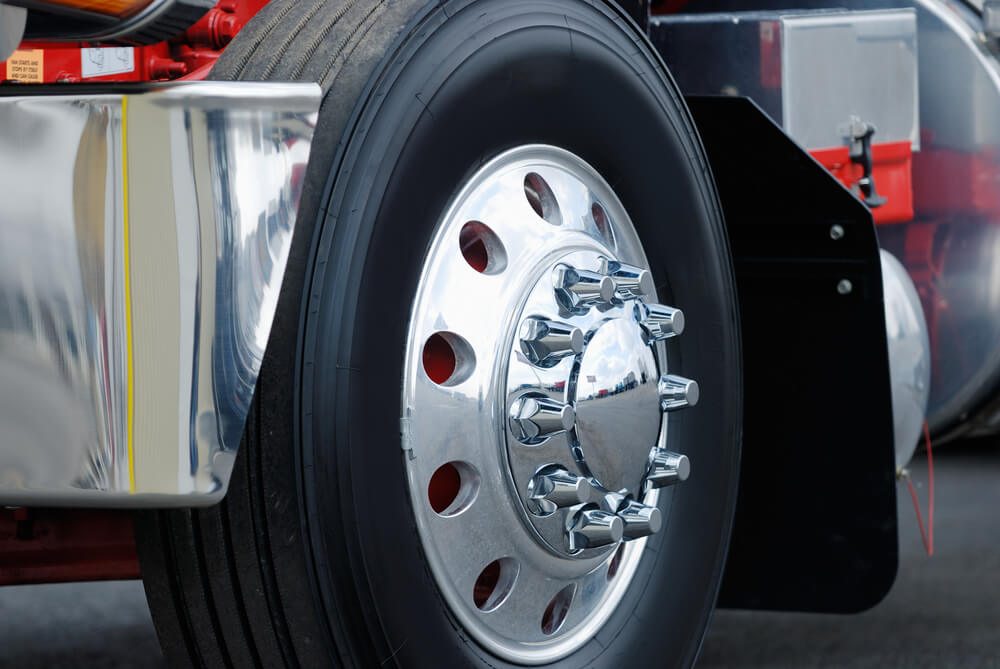|
Hauling & Collection Organics
Goodyear offers several self-sealing tires, including the G289 WHA DuraSeal and the G296 WHA DuraSeal, both of which have been designed for waste haul applications and both of which were displayed at Goodyear’s Waste Expo booth (#1537) May 21-23, 2013, at the Ernest N. Morial Convention Center in New Orleans, La.
Goodyear says the secret to these tires’ self-sealing capabilities is the company's DuraSeal Technology, a gel-like substance built into the tire’s inner liner that instantly repairs nail-hole punctures of up to ¼-inch in diameter in the tire’s repairable tread area.
“Goodyear is the only tire manufacturer that offers this extraordinary, uptime-preserving technology for commercial truck tires,” said Buckham.
During Waste Expo, attendees had an opportunity to see how DuraSeal works – and enter a drawing during Waste Expo to win a new iPad – by puncturing a G289 WHA DuraSeal tire using Goodyear’s Tire Popper, a device that consists of a lever that’s pulled down by hand to drive a spike into the tire’s tread area.
How DuraSeal Technology works
Goodyear DuraSeal Technology is built into the tread area of a truck tire’s casing. When a nail puncture in the repairable area of the tire’s tread occurs, the DuraSeal compound immediately surrounds the nail and seals the puncture.
DuraSeal helps protect the part of the tire where punctures most often occur. This is particularly beneficial for waste haul trucks that travel over debris-littered surfaces.
“Goodyear DuraSeal Technology helps preserve valuable uptime because tires that contain DuraSeal don’t have to be taken out of service for tread puncture repairs,” said Buckham. “In fact, we’ve seen DuraSeal tires hold air with multiple foreign objects imbedded in their tread area.
“In fact, we’ve seen DuraSeal tires hold air with multiple foreign objects imbedded in their tread area.
“If you think about how much uptime this preserved and the number of service calls that were avoided, it’s easy to see how a fleet’s bottom line can be improved through the use of Goodyear DuraSeal truck tires,” he explained. “This is another example of how Goodyear offers fleets a Total Package Solution, not just a tire.”
The G289 WHA DuraSeal and the G296 WHA DuraSeal
Both the G289 WHA DuraSeal and the G296 WHA DuraSeal are ideal for waste industry trucks that are required to travel across municipal and privately owned dumps, construction sites, waste transfer stations and other areas where the potential for tread punctures is high, according to Buckham.
In addition to Goodyear DuraSeal Technology, the G289 WHA DuraSeal contains a wide range of features designed to benefit waste haul fleets, including a deep 24/32-inch tread depth, which helps extend tread life in demanding waste haul applications. The G289 WHA DuraSeal is available in size 315/80R22.5 Load Range L.
The G289 WHA DuraSeal is available in size 315/80R22.5 Load Range L.
The G296 WHA DuraSeal, which is available in size 425/65R22.5 Load Range L, offers 23/32-inch tread depth, a high-scrub tread compound to extend tire life, and has a speed rating of 68 miles per hour.
“The G289 WHA DuraSeal and the G296 WHA DuraSeal are strong all-around performers that deliver a variety of real-world benefits to waste haul fleets,” said Buckham. “At the same time, they have been engineered for optimal road handling and wear, so trucks can travel to and from their destination with confidence.
New tire design features provide year-round performance and durability
DuraShield tire protection technology
Goodyear OMNITRAC S and OMNITRAC D tires are manufactured using original technology DuraShield. It provides for the presence in the design of an additional layer of a certain chemical composition, which protects the "breaker package" from external damage. DuraShield technology should not be confused with DuraSeal technology, which involves the use of a special material located on the inside of the tire that fills a puncture and, thereby, prevents air from escaping from the tire. We emphasize once again - DuraShield technology is a shield that protects the breaker from damage. Thanks to this design feature, the Goodyear OMNITRAC carcass has a greater chance of remaining intact on poor quality roads and being retreadable. As you know, factories responsible for the quality of their work accept only tires whose carcasses do not have critical damage. As we said above, DuraShield technology saves tires from tread cuts. Therefore, when operating equipment in difficult conditions (landfills and construction sites), it is important to do everything possible to prevent contact of the tire sidewalls with sharp objects.
DuraShield technology should not be confused with DuraSeal technology, which involves the use of a special material located on the inside of the tire that fills a puncture and, thereby, prevents air from escaping from the tire. We emphasize once again - DuraShield technology is a shield that protects the breaker from damage. Thanks to this design feature, the Goodyear OMNITRAC carcass has a greater chance of remaining intact on poor quality roads and being retreadable. As you know, factories responsible for the quality of their work accept only tires whose carcasses do not have critical damage. As we said above, DuraShield technology saves tires from tread cuts. Therefore, when operating equipment in difficult conditions (landfills and construction sites), it is important to do everything possible to prevent contact of the tire sidewalls with sharp objects.
With chip
Following the current trends in reducing the operating costs of a car company, optimizing accounting and tire maintenance (Flight magazine talked about systems developed by Goodyear), engineers integrated radio frequency identification (RFID) tags into the OMNITRAC design. Let us recall - Chips make it possible to automatically identify tires by a unique code, which is necessary to generate data for their accounting system and determine the maintenance policy. An intermediary in the "communication" between the tires and the database into which all information is entered can be both a mobile (for a warehouse) and a permanently installed (for example, at the entrance to the corresponding section of the tire center) scanner. We hasten to reassure fleet owners who widely practice the use of retreaded tires to reduce operating costs. Radio Frequency Identification (RFID) tags do not fail when exposed to temperatures that are typical for cold and hot recovery technologies. The chips are embedded in the tire structure at the tire assembly station and subjected to thermal treatment in autoclaves. Therefore, the heating of electronic components is provided during their development.
Let us recall - Chips make it possible to automatically identify tires by a unique code, which is necessary to generate data for their accounting system and determine the maintenance policy. An intermediary in the "communication" between the tires and the database into which all information is entered can be both a mobile (for a warehouse) and a permanently installed (for example, at the entrance to the corresponding section of the tire center) scanner. We hasten to reassure fleet owners who widely practice the use of retreaded tires to reduce operating costs. Radio Frequency Identification (RFID) tags do not fail when exposed to temperatures that are typical for cold and hot recovery technologies. The chips are embedded in the tire structure at the tire assembly station and subjected to thermal treatment in autoclaves. Therefore, the heating of electronic components is provided during their development.
Each axle has its own OMNITRAC
The division of tires according to positioning on the axles of the vehicle is typical not only for models intended for vehicles operating on a long arm (intercity and international routes), but also for construction segment vehicles that carry out transportation on a relatively short distances on roads of various qualities - from asphalt to dirt roads. A striking example of this is the transportation of bulk cargo by dump trucks / dump trucks. Part of the way the vehicle passes, for example, along a quarry and part along asphalt to the place of unloading (construction site, transshipment base, etc.).
A striking example of this is the transportation of bulk cargo by dump trucks / dump trucks. Part of the way the vehicle passes, for example, along a quarry and part along asphalt to the place of unloading (construction site, transshipment base, etc.).
Goodyear OMNITRAC tires, according to modern trends, are also divided according to their installation on the vehicle axle, and, accordingly, have their own design features, including the tread pattern. For example, Goodyear OMNITRAC D drive axle tires have a tread pattern with a pronounced central rib that takes up the load. The open structure shoulder blocks include grooves that effectively evacuate dirt from the contact patch, contributing to the self-cleaning of the tread. The design contains stone ejectors. In order to reduce the likelihood of destruction / chipping of blocks, jumpers have been introduced into the tread pattern that prevent this process. When it comes to the tread pattern of the Goodyear OMNITRAC S steering tire, the classic ribbed design is clearly visible here, but with enough lugs for good grip on all types of roads.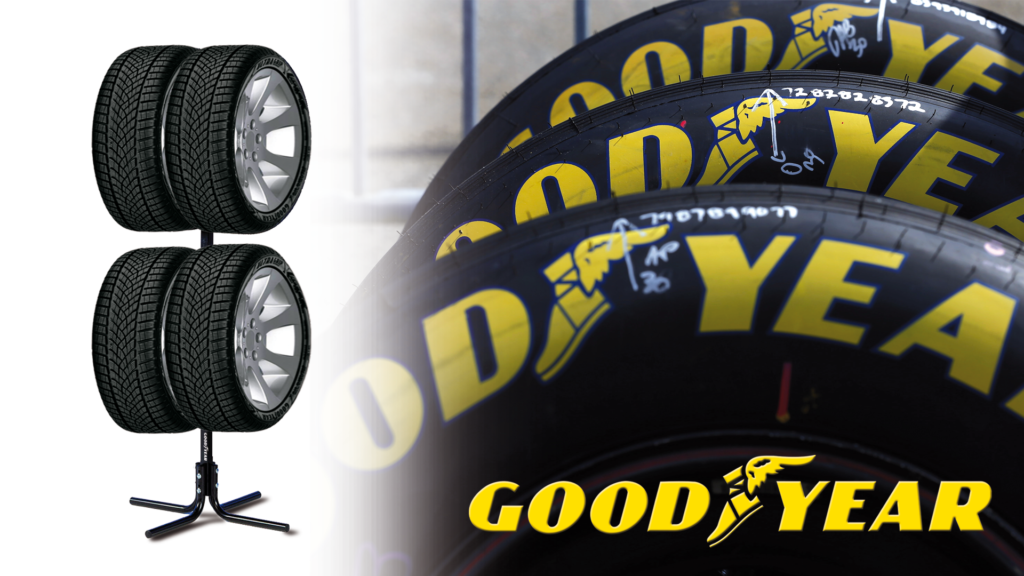
And in the end - intrigue! Another Goodyear OMNITRAC Heavy Duty mixed-use tire line will soon be introduced to the market. That is, carriers will be presented with a reinforced version of mixed-use tires designed to work in particularly difficult conditions. This is a topic for a separate article. Follow our publications.
In the world of passenger tires, new product lines are often dictated by both car and driving trends. In the world of truck tires, the most common reasons for introducing new technologies and updating the range are economics and the organization of cargo transportation.
At two international exhibitions held in Moscow, the main players in the commercial vehicle tire market presented their new products: Continental, Goodyear and Michelin. Each of the companies has its own original technological developments, design finds that allow to use the full potential of trucks and special vehicles, trailers and semi-trailers.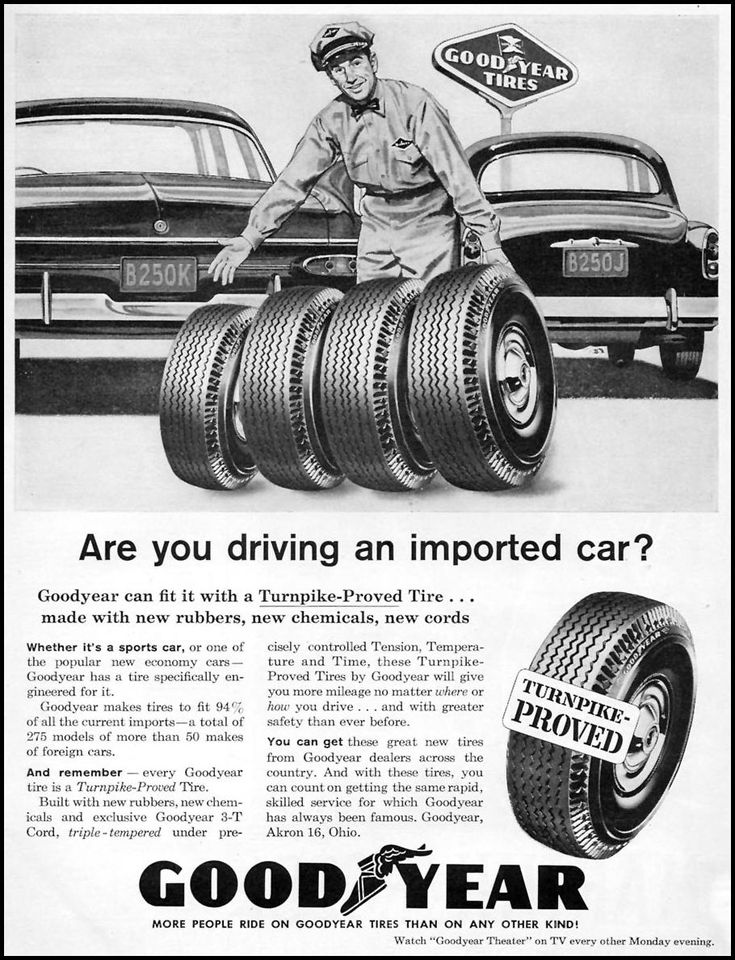 Such activity of the leading tire manufacturers is explained by the fact that at the end of 2012 new EU directives are introduced that define the requirements for tires, including those for commercial vehicles and special equipment.
Such activity of the leading tire manufacturers is explained by the fact that at the end of 2012 new EU directives are introduced that define the requirements for tires, including those for commercial vehicles and special equipment.
Continental
The new all-round tire Continental HD Hybrid is ideal for hauling loads over long distances and for regional hauls on medium quality roads. Thanks to the use of new technology in the manufacture of the tread with a combined linear-block structure, the tires guarantee maximum grip on the road.
The range of applications for HD Hybrid tires is extremely wide: from motorways (Motorway) to roads with difficult road surfaces (Allround). The new high-tech and versatile tires complement two second-generation tire models introduced last year that offer significant savings in transportation costs.
The versatility of the new tires is defined by an innovative tread pattern with a mixed linear-block profile. Tires with longitudinal grooves can significantly reduce rolling resistance and at the same time increase the tread depth, which guarantees low fuel consumption and extends tire life. At the end of the tire's half-life, the groove, which has undergone a special three-dimensional treatment, turns into a tread that reaches the base of the profile. The profile structure, which looked like a groove in a new tire, narrows when it reaches half the depth and forms a serrated tread. Thus, during its service life, the tire changes its appearance without changing its properties.
Tires with longitudinal grooves can significantly reduce rolling resistance and at the same time increase the tread depth, which guarantees low fuel consumption and extends tire life. At the end of the tire's half-life, the groove, which has undergone a special three-dimensional treatment, turns into a tread that reaches the base of the profile. The profile structure, which looked like a groove in a new tire, narrows when it reaches half the depth and forms a serrated tread. Thus, during its service life, the tire changes its appearance without changing its properties.
This technology provides excellent grip on ice and snow and optimum handling in wet conditions. Thanks to the lowest possible rolling resistance, the HD Hybrid becomes the leader in fuel efficiency in its class.
Of course, the latest carcass technology of the second generation is used for the latest tire model. The four layers of the triangular belt absorb lateral and longitudinal forces to reduce rolling resistance and ensure even wear. The significantly increased air chamber volume of the new second-generation tires noticeably increases tire load and mileage.
The significantly increased air chamber volume of the new second-generation tires noticeably increases tire load and mileage.
The new HD Hybrid tires use the patented AirKeep technology to prevent pressure loss in truck tires thanks to the extremely dense molecular structure of the inner layer.
New generation tires play an important role in transport, where modern trucks are subject to extremely high demands due to the variety of applications.
“With the HD Hybrid, Continental is offering customers an even more economical and versatile solution!” says Hartwig Kühn, Product and Sales Manager for Continental Truck Tires.
The new HD Hybrid will be available in sizes 295/60R22.5, 315/60R22.5. 315/70R22.5, 295/80R22.5 and 315/80R22.5.
The HD Hybrid will be, according to Continental's brand manager, the best-selling type of drive axle tire, with a market share of 50%. At Continental, this market segment is currently dominated by the all-in-one HDR model. The market change will come even faster as a result of a comprehensive tire retreading program: those fleet operators who previously opted for HDL and HDR models can opt for the HD Hybrid tread pattern when retreading as the carcasses of these models are completely are the same. This will be possible from 2011. In the future, Continental will have other types of hybrid tires.
The market change will come even faster as a result of a comprehensive tire retreading program: those fleet operators who previously opted for HDL and HDR models can opt for the HD Hybrid tread pattern when retreading as the carcasses of these models are completely are the same. This will be possible from 2011. In the future, Continental will have other types of hybrid tires.
By the way, the first customers are already carrying out trial operation of new tires and have a positive experience with them.
Goodyear
Goodyear has introduced a new generation of trailer tires with Goodyear's Max Technology FuelMax technology.
TheMarathon LHT II is the latest member of Goodyear's new tire family, which also includes the Marathon LHS II and Marathon LHD II tires.
The use of tires LHS II for the steer axle, LHD II for the drive axle and LHT II for a conventional 40 ton three-axle trailer saves up to 2,300 euros annually and reduces CO2 emissions by 5,200 kg per vehicle. The LHT II tires weigh 7.5 kg less than the previous model and are therefore able to increase the load capacity of a three-axle trailer by 45 kg.
The LHT II tires weigh 7.5 kg less than the previous model and are therefore able to increase the load capacity of a three-axle trailer by 45 kg.
The tire carcass features redesigned 3D-modeled components to reduce temperature and rolling resistance, key ingredients for improved energy consumption and durability. Steel belts in the tread area provide stability and reduce energy loss. The carcass shape and bead contribute to low rolling resistance while maintaining tread retreadability. Other benefits include variable peripheral groove characteristics that provide tough resistance to cracking and stone damage. State-of-the-art high silica tread compound technology provides the perfect balance between rolling resistance, wet braking and mileage.
The LHT II already meets the 2012 tire requirements. Goodyear expects the LHT II to perform well under the new EU tire label. All Goodyear truck tires are retreadable and regroovable.
The Goodyear Marathon LHT II tires will be available in September 2010 in three sizes.
Marathon LHT II Load/Speed On sale from
385/55R22.5 160 K (158 L) September 2010
435/50R19.5 160 J September 2010
385/65R22.5 160 K (158 L) September 2010
Omnitrac Mixed Service tires Steer II and Omnitrac Mixed Service Drive II (MSS II and MSD II) for steer and driven axles combine excellent off-road traction, increased mileage and improved wet braking. These are the first representatives of the mixed service tire line - for mixed operating conditions on dirt and asphalt roads and designed specifically for construction trucks. They are part of the Max Technology concept, combining the latest generation of materials and progressive design. The tire design is designed in such a way that MSD II tires increase mileage by 17%, while MSS II and MSD II reduce rolling resistance, which is also a benefit in terms of cost reduction.
Tire design with tread components for improved damage resistance, rigid carcass and optimized tread pattern improves braking performance and reduces noise levels. As a result, the tires provide excellent mileage and grip, as well as retreadability. Among the advantages of tires - a wide tread for increased mileage, protection from stones, the ability to clear mud and restore the tread pattern.
As a result, the tires provide excellent mileage and grip, as well as retreadability. Among the advantages of tires - a wide tread for increased mileage, protection from stones, the ability to clear mud and restore the tread pattern.
The new DuraSeal technology is available for MSS II and MSD II tires, a first for Omnitrac tires designed for use on dirt and asphalt roads. With a built-in insulating layer in the tread, this patented technology prevents the tire from losing air in case of a puncture less than 6mm in diameter. In the event of a tire puncture, trucks do not require mandatory shutdown, which reduces downtime.
The company has also developed the low profile MSD II tire for single-drive trucks in sizes 385/55R22.5 and 495/45R22.5, which was created in collaboration with Mercedes and Renault Trucks. Compared to previous models, they offer better traction and wet grip. So, the simultaneous use of MSS II and MSD II tires increases traction on unpaved surfaces by 6% and improves tire grip on wet roads.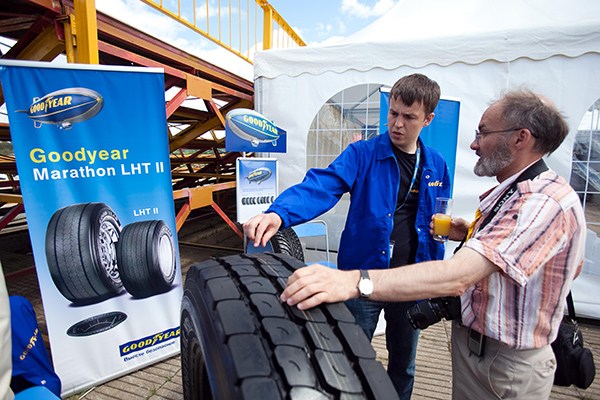 Wet braking is up to 3% better, with wet tests showing that using these tires together improves wet grip by 2%. The Omnitrac MSS II and MSD II tires are fully compliant with EU Directive 661 on rolling resistance and noise levels two years prior to its official entry into force.
Wet braking is up to 3% better, with wet tests showing that using these tires together improves wet grip by 2%. The Omnitrac MSS II and MSD II tires are fully compliant with EU Directive 661 on rolling resistance and noise levels two years prior to its official entry into force.
DuraSeal tires available July 2010
Omnitrac MSS II Load/Speed
315/80R22.5 156/150 K
13R22.5 1 Load56/150 K
Omnitrac II. /Speed
315/80R22.5 156/150K
13R22.5 156/150K
385/55R22.5
(super single drive) 160K
495/45R22.5
(super single drive) 169 9002 9002 Michelin
Michelin introduced the new tires XHA2, X-Super Terrain AD and X-Traction at the CTT-2010 international trade show. The new range of oversized tires has been developed by Michelin in collaboration with industrial equipment manufacturers.
The XHA2 tire is designed for medium loaders used in quarries, cement plants and construction. The XHA2 tire range, first introduced to the world market in 2009, has been expanded with two new sizes: 20.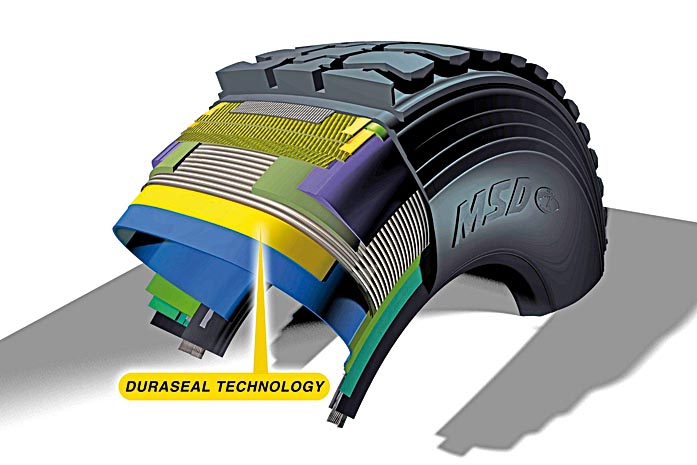 5R25 TL and 29.5R25TL. Starting from July 2010, the new tire will be supplied to the assembly lines of equipment manufacturers. Durability is one of the main qualities of a new tire. It is this that allows her to demonstrate high performance and possess all the necessary qualities when performing any general construction work. Tires XHA2 are installed on wheel loaders. These machines operate in off-road conditions and are often used for continuous loading. The company's specialists have increased the tread layer (compared to XHA) for better resistance to damage, reinforced the sidewalls with an additional protective layer, reducing the likelihood of damage, and applied an impact-absorbing rubber compound to help prevent punctures. Tire life is 10% longer than the predecessor XHA.
5R25 TL and 29.5R25TL. Starting from July 2010, the new tire will be supplied to the assembly lines of equipment manufacturers. Durability is one of the main qualities of a new tire. It is this that allows her to demonstrate high performance and possess all the necessary qualities when performing any general construction work. Tires XHA2 are installed on wheel loaders. These machines operate in off-road conditions and are often used for continuous loading. The company's specialists have increased the tread layer (compared to XHA) for better resistance to damage, reinforced the sidewalls with an additional protective layer, reducing the likelihood of damage, and applied an impact-absorbing rubber compound to help prevent punctures. Tire life is 10% longer than the predecessor XHA.
Patented tread pattern significantly reduces operator discomfort and transmission wear. The larger footprint of the XHA2 tire reduces machine sway caused by frequent changes in direction during operation. The tread pattern improves traction and promotes self-cleaning of the tire (removal of soil from the interblock space of the tread), which reduces its slippage. Due to its greater durability, the tire can be easily retreaded, resulting in further cost savings for the user company, while its traction characteristics reduce rolling resistance and fuel consumption.
The tread pattern improves traction and promotes self-cleaning of the tire (removal of soil from the interblock space of the tread), which reduces its slippage. Due to its greater durability, the tire can be easily retreaded, resulting in further cost savings for the user company, while its traction characteristics reduce rolling resistance and fuel consumption.
Available sizes
20.5R25
23.5R25
26.5R25
29.5R25
X-Traction tire designed for mining trucks. The first tire of this range appeared back in 2004, it was presented in only one size 27.00R49 and was intended for mining trucks with a payload capacity of 80-100 tons. Today, Michelin introduces tires with a bore diameter of 33” and 35”. They are designed for smaller haul trucks, which are increasingly being chosen to improve production efficiency.
When developing the X-Traction tire, the company applied two new technologies that provide the tire with the ability to work at higher speeds: Cooling System - a new additional element in the tire shoulder tread and C2 technology - a new structure of the tire carcass.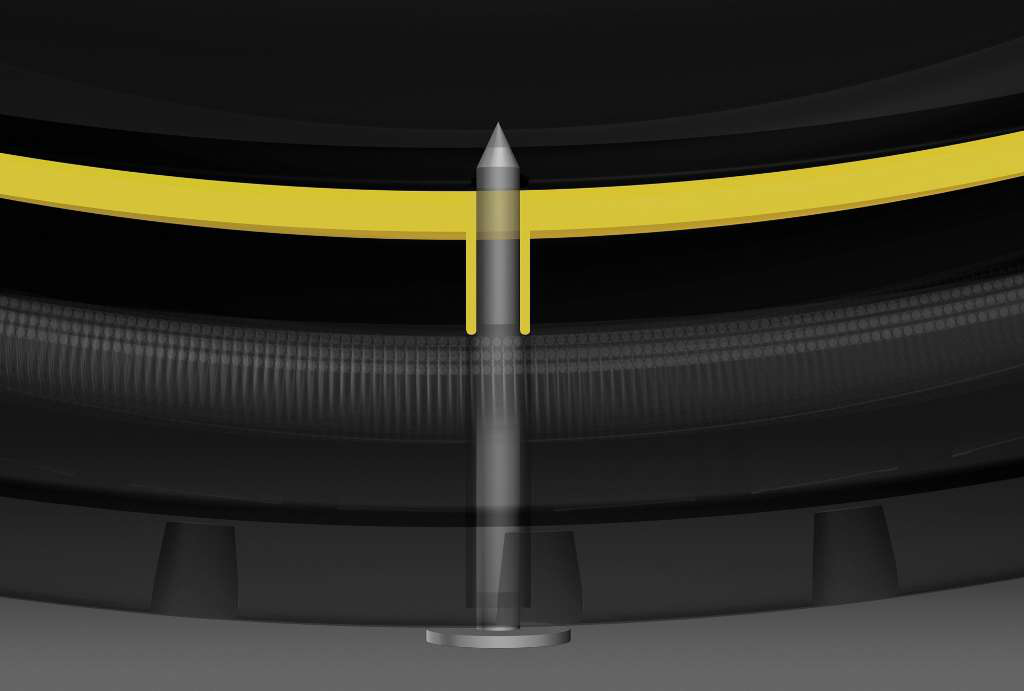
X-Traction is lighter, helping to save 5% fuel and consequently reduce CO2 emissions. Another advantage of the new tire is the increased initial tread depth (from 7 to 9 mm), which increases its service life and resistance to damage by about 15%. A durable protector reliably protects its frame. In the near future, the size range of the tire will be replenished with three standard sizes: in September 2010, 24.00R35 will appear on the market, and in 2011 - 21.00R33 and 18.00R33.
Available sizes
27.00R49
24.00R35 (since September 2010)
18.00R33 (since 2011)
21.00R33 (since 2011) for articulated dump trucks operating in off-road conditions. The tire has 10% better grip than the XADT tire, allowing you to get the job done faster. The new tread pattern increases longitudinal and lateral grip and promotes self-cleaning of the tire (removal of soil from the tread interblock space), which reduces tire slip. The tread of the new tire is deeper and more durable, which increases its wear resistance.